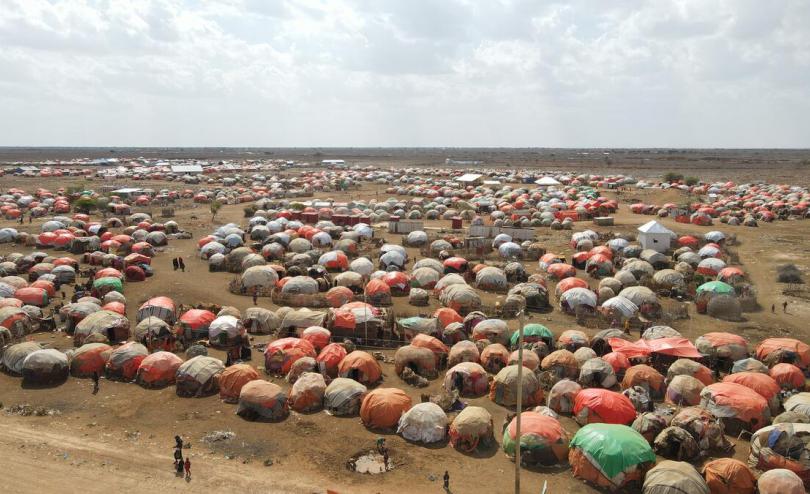HORN OF AFRICA DROUGHT: Fears mount as rains failing for the fourth time and war in Ukraine sends food prices rocketing

NAIROBI, 21 April 2022 – A poor start to the rainy season in the Horn of Africa has added to fears that the worst drought in decades could soon have catastrophic results, with the crisis worsened by the war in Ukraine driving up food prices and diverting international attention, Save the Children said.
More than 16 million people—including many children—are already in dire need of food aid in Somalia, Kenya and Ethiopia, which are now staring at an unprecedented fourth consecutive failed rainy season, having received below average rains so far this March to May wet season.
Kenya and Ethiopia have only received light showers after seven weeks of the rainy season. Forecasts from the Kenya Meteorological Department and Ethiopia’s Crop Monitor for Early Warning point to a below average season, warning this could push more people into a desperate situation. Already, 3.5 million people in Kenya are short of food and up to 6.5 million people in Southern Ethiopia need aid.
In Somalia, nearly one third of the population, or 4.8 million people, are facing acute food shortage and the UN has warned of a looming famine in three months due to the drought-causing La Niña weather system, inadequate humanitarian assistance, and rising food prices. This has raised fears of a repeat of a 2011 famine that killed 260,000 people, half aged under five.
Save the Children staff in Somalia said only a few pockets of the drought-stricken country had received small amounts of rain two weeks into the season. Forecasts show an increased likelihood of below-average rain this April-June season in central and southern Somalia where millions of pastoralists have been forced from their homes to live in displacement camps.
On top of one of the worst droughts in decades and huge funding shortfalls, the escalation of war in Ukraine seven weeks ago is threatening to push families and children in the Horn of Africa further into misery, Save the Children said.
The cost of food in the region was already on an upward trend, driven by climate shocks, locust invasions, conflict, and tough economic times brought about by the COVID-19 pandemic. But the escalation of the conflict in Ukraine has created shockwaves in the food markets.
Bread is a staple food in East Africa, with wheat and wheat products accounting for one third of the average cereal consumption in the region. The demand is mainly met by imports (84%), of which 90% of wheat imports come from Russia (72%) and Ukraine (18%)[i] and with prices rising in the past seven weeks.
Russia and Ukraine also account for nearly three-quarters of global exports of sunflower oil, also a widely-used commodity in the region.
In Somalia’s Puntland state, the price of wheat flour has jumped from $26 to $32 per 50kg bag, and up to $36 in the towns of Garowe and Qardho[ii]. In the capital of Mogadishu, the price of a 3-litre container of cooking oil had tripled to $9 in March this year from $3 in January. Prices in rural areas have surged higher, up to $12 a container, which is attributed to an increase in the price of transportation as a result of higher fuel prices.
In Ethiopia, the price of sorghum and maize increased by 9% and 4%, respectively, between February and March, while its protein-rich staple food, teff, saw its prices jump by 1% from $0.93 per kilo in March to $0.94 in April.[iii] Save the Children staff are also reporting massive price hikes for sunflower oil.
Besides immediate food access and availability, there are concerns over the longer term impact on food production due to higher fuel prices and soaring costs of fertilizer.
Russia is the world’s largest exporter of nitrogen fertilizers and the conflict has pushed up prices at a time when the main planting season (March to May) is underway in Africa.
In Kenya, the price of a bag of fertilizer jumped by 50% last year to about US$60 and has risen further to US$70[iv] since 24 February. This will mean smallholder farmers use fewer fertilizers resulting in lower productivity, while large scale farmers are hit by fuel costs for tractors and other machinery.
Save the Children’s Country Director for Somalia, Mohamud Mohamed Hassan, said:
“As Somalia is facing yet another cycle of drought, the situation is getting worse by the day and the war in Ukraine has dealt a serious blow to what was already a perilous situation. Somalia relies heavily on food imports to feed its people. More than 90%[v] of Somalia’s wheat flour imports come from Russia and Ukraine and any decline in trade is bound to push the food basket further away from families and children and further compound the impact of the drought. With skyrocketing food and fuel prices across Somalia and the Horn of Africa, we reiterate that the time to act and avert a catastrophe is now.”
In Somalia, more than 720,000 people have abandoned their homes in search of food and water in the past eight months with their ability to cope already eroded by decades of conflict, political instability, climate shocks and COVID-19. The UN estimates that 1.4 million children[vi] could be acutely malnourished by the middle of the year – up 64% from two years ago – with 330,000 severely malnourished if the deteriorating situation was not addressed.
Malnutrition cases are also soaring in Kenya where 755,000 children require urgent treatment for acute malnutrition, with 103,000 pregnant and breast-feeding mothers acutely malnourished and in need of urgent treatment.
Save the Children’s Country Director for Kenya, Yvonne Arunga, said:
“In Kenya’s arid and semi-arid regions, people are facing an emergency food situation and children are having to contend with one meal a day. Without urgent intervention, every hour pushes families and children closer and closer to the brink of starvation. We are urgently calling on the international community to make more funds available for the drought response before the situation gets out of hand.”
There is a US$4.4 billion UN humanitarian appeal for Ethiopia, Kenya and Somalia but funding is extremely low, with concerns that the Ukraine conflict is dominating the international spotlight with other global crises starting to fall below the radar.
In Ethiopia, Save the Children is warning that a prolonged and devastating drought is grinding away at the resilience of children and families, already worn down by 16 months of conflict and two years of the COVID-19 pandemic.
At least 8.1 million people need immediate food aid, with over 286,000 people forced to abandon their homes in search of food and water.[vii] Save the Children said pastoralist families have now lost over 1.46 million livestock. This has led to children missing out on milk, their main source of nutrition, with up to 890,000 children aged under five now suffering from malnutrition.
Save the Children’s Country Director for Ethiopia, Xavier Joubert, said:
“The hunger crisis in Ethiopia is predicted to get worse in the coming months due to the predicted fourth below-average rainy season and the approaching lean season which runs between June to September. Families in the Dawa zone of Somali region have been reported to adopt all possible coping mechanisms due to the food shortage, including skipping meals and reducing food portions.”
Save the Children has worked in the Horn of Africa for over 70 years and is a national and international leader in humanitarian and development programming in health, nutrition, water hygiene and sanitation, education, child protection and child rights governance. In 2021, Save the Children reached 12,185,726 people in Ethiopia, Kenya and Somalia, including more than 7,624,620 children.
[i] WFP (2022) Implications of Ukraine Conflict on Food Access and Availability in the Eastern Africa Region
[ii]https://reliefweb.int/report/somalia/somalia-joint-market-and-supply-chain-update-13th-march-2022-20th-march-2022
iiWFP (2022) Implications of Ukraine Conflict on Food Access and Availability in the Eastern Africa Region
[iii] Ethiopia Joint Market Monitoring Initiative and cereal retailer in Addis Ababa
[vi] Urgent support needed for 1.4 million children likely to suffer from acute malnutrition in Somalia - Unicef UK
[vii] OCHA data




